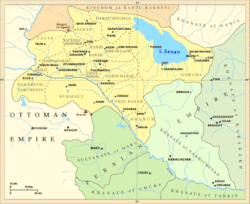| Revision as of 07:19, 28 February 2007 view sourceAlpertunga5000 (talk | contribs)1,808 edits added {{Azerbaijan-stub}}← Previous edit | Revision as of 08:55, 28 February 2007 view source ROOB323 (talk | contribs)Extended confirmed users4,063 edits I am really getting tierd of this Adil, you need to take your POW to somewhere else. I thought you said you don't add information without sources in sensetive articles I guess you liedNext edit → | ||
| Line 1: | Line 1: | ||
| ] | ] | ||
| ] | ] | ||
| The '''Erivan''' (]), '''Erwan''' (آرون) or '''Irevan''' ] was |
The '''Erivan''' (]), '''Erwan''' (آرون) or '''Irevan''' ] was a ] principality mostly under the dominion of the ] between 1747 and 1828, roughly corresponding to most of present-day central ], the ] of ], and the ] and ] rayons of ]'s ] exclave. As a result of the Persian defeat in the last ], it was ceded to the ] in accordance with the ]. | ||
| During the existence of the Erivan khanate, its population consisted primarily of ] (settled largely around the capital), ] (both settled and seminomadic), and ] (largely nomadic).<ref name="hewsen">{{cite book | last = Hewsen | first = Robert H. | title = Armenia: A Historical Atlas | year = 2001 | publisher = ] | id = ISBN 0-226-33228-4 | pages = p. 168 }}</ref> ] was the predominate faith of the khanate (with some Kurds of the ] school). <ref name="hewsen" /> ]s were also known to be numerous. <ref name="hewsen" /> ] formed less than 20% of the population <ref name="hewsen" /> as a result of ]'s deportation of much of the Armenian |
During the existence of the Erivan khanate, its population consisted primarily of ] (settled largely around the capital), ] (both settled and seminomadic), and ] (largely nomadic).<ref name="hewsen">{{cite book | last = Hewsen | first = Robert H. | title = Armenia: A Historical Atlas | year = 2001 | publisher = ] | id = ISBN 0-226-33228-4 | pages = p. 168 }}</ref> ] was the predominate faith of the khanate (with some Kurds of the ] school). <ref name="hewsen" /> ]s were also known to be numerous. <ref name="hewsen" /> ] formed less than 20% of the population <ref name="hewsen" /> as a result of ]'s deportation of much of the Armenian population from the Ararat valley and the surrounding region in ].<ref name="vonhaxthausen ">{{cite book | last = von Haxthausen | first = Baron | title = Transcaucasia: Sketches of the Nations and Races between the Black Sea and the Caspian | year = 2000 | publisher = Adamant Media Corporation | id = ISBN 1402183674 | pages = p. 252 }}</ref> | ||
| ==References== | ==References== | ||
| Line 15: | Line 15: | ||
| ] | ] | ||
| {{Azerbaijan-stub}} | |||
| {{Armenia-hist-stub}} | {{Armenia-hist-stub}} | ||
| {{Iran-stub}} | {{Iran-stub}} | ||
Revision as of 08:55, 28 February 2007

The Erivan (Yerevan), Erwan (آرون) or Irevan khanate was a Muslim principality mostly under the dominion of the Persian Empire between 1747 and 1828, roughly corresponding to most of present-day central Armenia, the Iğdır Province of Turkey, and the Sharur and Sadarak rayons of Azerbaijan's Nakhichevan exclave. As a result of the Persian defeat in the last Russo-Persian War, it was ceded to the Russian Empire in accordance with the Treaty of Turkmanchai.
During the existence of the Erivan khanate, its population consisted primarily of Persians (settled largely around the capital), Azerbaijanis (both settled and seminomadic), and Kurds (largely nomadic). Shia Islam was the predominate faith of the khanate (with some Kurds of the Sunni school). Yazidis were also known to be numerous. Armenians formed less than 20% of the population as a result of Shah Abbas I's deportation of much of the Armenian population from the Ararat valley and the surrounding region in 1605.
References
- ^ Hewsen, Robert H. (2001). Armenia: A Historical Atlas. The University of Chicago Press. pp. p. 168. ISBN 0-226-33228-4.
{{cite book}}:|pages=has extra text (help) - von Haxthausen, Baron (2000). Transcaucasia: Sketches of the Nations and Races between the Black Sea and the Caspian. Adamant Media Corporation. pp. p. 252. ISBN 1402183674.
{{cite book}}:|pages=has extra text (help)
See also
This Armenian history-related article is a stub. You can help Misplaced Pages by expanding it. |
This Iran-related article is a stub. You can help Misplaced Pages by expanding it. |